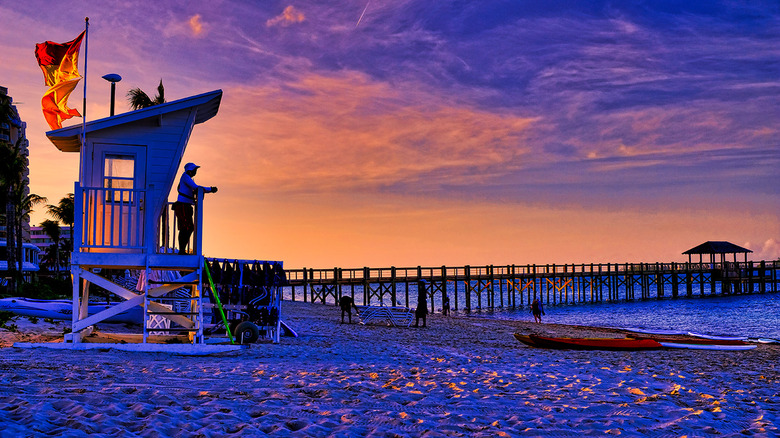What Does Bahamas Conch Taste Like?
Hunting down the prized ocean delicacy in the Bahamas
I awoke with a start as the plane touched down, shaking off the daydream residue of cays and grottos, and looked out the window at the sun-drenched reverie known as the Bahamas.
I came not as part of the winter migratory flux that flees sleet and storm to wallow in sand and surf, but to find out about conch. What's conch, you ask? The hallowed Merriam-Webster defines it as "any of various large spiral-shelled marine gastropod mollusks," which is the long way of saying that it doesn't know either.
Conch is a seafood indigenous to the Bahamas. My journey to understand it began more than 20 years ago, when I was a neophyte cook in the panhandle of Florida. I'd often heard of conch (from the cookbooks of Florida-fusion master Norman Van Aken) and sometimes ate it (from cans). It was something like a cross between scallops and squid, but came in bits and hunks, so it was like eating the pieces of a puzzle. To make matters more confusing, it's pronounced conk: The h is silent.
The next morning, I left my home base of the luxurious hotel and resort called Baha Mar, a sort of utopian Disneyland of all things Bahamian, from food to culture and beyond. Wobbling in a boat below, I found the smiling faces of fishermen John and Pedro Culmer, the second and third generations of their fishing family, who supply the resort with all of their conch. After their salt-water-crusted shirts, the next thing I noticed about them was their piercing crystal-blue eyes that mirrored the turquoise waters around them. I imagined that like the Fremen in Dune, their physical appearance had adapted to their environment over the years, their eyes reflecting their trade and the surrounding sea.

Pedro grabbed a huge, ornate, pink-orange shell that curled and spiraled. This was the conch, or at least where it lived. He smashed a small hole in the shell and, using a knife, pushed out the meat of the conch. It had the shape of a hand of ginger with coloring reminiscent of the rainbow effect of a puddle on a wet road. He pulled off the pistil and handed it to me.
"It tastes like a salty jelly bean," he said with a smile. I smiled weakly and gulped it down. A shot of brine went through me like a pickleback. Limes appeared from nowhere, as Pedro cut off raw pieces of conch and drenched them with citrus juice. "Conch is the national dish," John, his son, said. "You can do a lot with it: stew conch, conch and rice, minced, conch salad, conch fritters, steamed . . .," he went on in an unselfconscious, Gumpian stream of thought.
Back on shore, I headed to the Conch Shack, which specializes in the ceviche-like conch salad and where they plow through 50 to 60 a day. There were four kinds: conch salad; scorched salad, in which the chefs lightly score the flesh to let in even more lime juice; tropical salad; and the old-fashioned salad, which server Rodkeysha Taylor called "the triple-OG version." The prep for each salad—a mountainous dice of onions, peppers, chiles and tomatoes—would take a normal person hours to chop. Here, they did it in minutes, using a flashy two-knife technique and a lifetime of know-how. I finally made up my mind on which one to order—I asked for all four. Each was an exhilarating blend of spicy heat and tender salty conch, all with a rousing blast of citrus.

Later that night, I met chef Derek Powers at L.A. import Katsuya, a mix of high-impact izakaya and sushi in a room that resembles a spaceship. "Conch is everywhere here," he says. "I used to work in Miami, and they had it here and there, but in the Bahamas, you have to really learn how to use it—it's a must." Powers proceeded to whack a coconut in half and nestle it into a bed of ice. He scooped spoonfuls of conch salad into the stark-white coconut, then gave it a pompadour of coconut foam with grand flourish. As I was taking another bite, I looked over at our waiter, who was shaking his head in amazement. "I'm Bahamian, man; we don't do it like that," he said with a laugh, as the chef pat him on the back. "I love mine with strawberries—go to H`annigan's at the fish fry; he's amazing!" Clearly, conch salad in the Bahamas is like pasta with the Italians : Every recipe is different, and everyone knows best.
At my last stop, the Royal Blue Tavern, I found nimble chef Kevyn Pratt dancing behind the stove, making conch chowder. "We have onions, goat pepper and thyme in here, the basis of Bahamian cuisine every day—twice on Sunday," he said laughing. "I did the thyme the down-home way—I threw the whole thing in."

Only 27 years old, the self-described "hella-young" native chef is ready to make an impact on the island. "Nothing frozen, nothing flown in," Pratt said. "If you come here, you want Bahamian cuisine. We are homegrown; I give that to you."
The chowder was just like the one his mother makes, but he added cream to make it his own. Once finished, it tasted like a cross between Manhattan and New England clam chowder with the spice and smack of the Caribbean, while the coarse meatiness of the conch threw shade at its cousin, the clam. "Conch is pure Bahamas," Pratt said with a knowing smile. "It's as Bahamian as you can get."
Todd Coleman is the creative director and editor at large for Tasting Table. Follow him on Instagram at @toddwcoleman.
